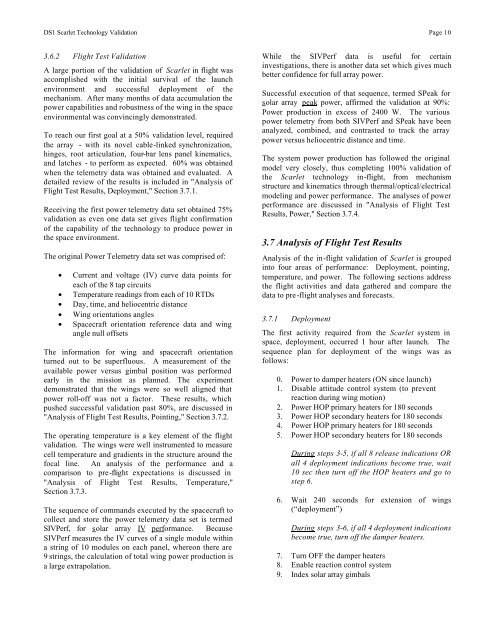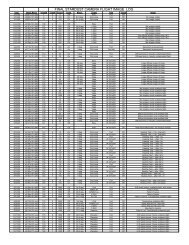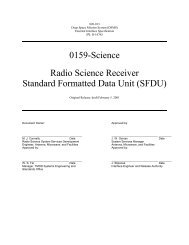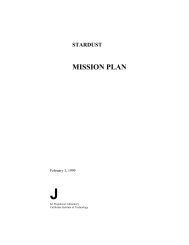The Scarlet Solar Array - PDS Small Bodies Node
The Scarlet Solar Array - PDS Small Bodies Node
The Scarlet Solar Array - PDS Small Bodies Node
- No tags were found...
Create successful ePaper yourself
Turn your PDF publications into a flip-book with our unique Google optimized e-Paper software.
DS1 <strong>Scarlet</strong> Technology Validation Page 10<br />
3.6.2 Flight Test Validation<br />
A large portion of the validation of <strong>Scarlet</strong> in flight was<br />
accomplished with the initial survival of the launch<br />
environment and successful deployment of the<br />
mechanism. After many months of data accumulation the<br />
power capabilities and robustness of the wing in the space<br />
environmental was convincingly demonstrated.<br />
To reach our first goal at a 50% validation level, required<br />
the array - with its novel cable-linked synchronization,<br />
hinges, root articulation, four-bar lens panel kinematics,<br />
and latches - to perform as expected. 60% was obtained<br />
when the telemetry data was obtained and evaluated. A<br />
detailed review of the results is included in "Analysis of<br />
Flight Test Results, Deployment," Section 3.7.1.<br />
Receiving the first power telemetry data set obtained 75%<br />
validation as even one data set gives flight confirmation<br />
of the capability of the technology to produce power in<br />
the space environment.<br />
<strong>The</strong> original Power Telemetry data set was comprised of:<br />
• Current and voltage (IV) curve data points for<br />
each of the 8 tap circuits<br />
• Temperature readings from each of 10 RTDs<br />
• Day, time, and heliocentric distance<br />
• Wing orientations angles<br />
• Spacecraft orientation reference data and wing<br />
angle null offsets<br />
<strong>The</strong> information for wing and spacecraft orientation<br />
turned out to be superfluous. A measurement of the<br />
available power versus gimbal position was performed<br />
early in the mission as planned. <strong>The</strong> experiment<br />
demonstrated that the wings were so well aligned that<br />
power roll-off was not a factor. <strong>The</strong>se results, which<br />
pushed successful validation past 80%, are discussed in<br />
"Analysis of Flight Test Results, Pointing," Section 3.7.2.<br />
<strong>The</strong> operating temperature is a key element of the flight<br />
validation. <strong>The</strong> wings were well instrumented to measure<br />
cell temperature and gradients in the structure around the<br />
focal line. An analysis of the performance and a<br />
comparison to pre-flight expectations is discussed in<br />
"Analysis of Flight Test Results, Temperature,"<br />
Section 3.7.3.<br />
<strong>The</strong> sequence of commands executed by the spacecraft to<br />
collect and store the power telemetry data set is termed<br />
SIVPerf, for solar array IV performance. Because<br />
SIVPerf measures the IV curves of a single module within<br />
a string of 10 modules on each panel, whereon there are<br />
9 strings, the calculation of total wing power production is<br />
a large extrapolation.<br />
While the SIVPerf data is useful for certain<br />
investigations, there is another data set which gives much<br />
better confidence for full array power.<br />
Successful execution of that sequence, termed SPeak for<br />
solar array peak power, affirmed the validation at 90%:<br />
Power production in excess of 2400 W. <strong>The</strong> various<br />
power telemetry from both SIVPerf and SPeak have been<br />
analyzed, combined, and contrasted to track the array<br />
power versus heliocentric distance and time.<br />
<strong>The</strong> system power production has followed the original<br />
model very closely, thus completing 100% validation of<br />
the <strong>Scarlet</strong> technology in-flight, from mechanism<br />
structure and kinematics through thermal/optical/electrical<br />
modeling and power performance. <strong>The</strong> analyses of power<br />
performance are discussed in "Analysis of Flight Test<br />
Results, Power," Section 3.7.4.<br />
3.7 Analysis of Flight Test Results<br />
Analysis of the in-flight validation of <strong>Scarlet</strong> is grouped<br />
into four areas of performance: Deployment, pointing,<br />
temperature, and power. <strong>The</strong> following sections address<br />
the flight activities and data gathered and compare the<br />
data to pre-flight analyses and forecasts.<br />
3.7.1 Deployment<br />
<strong>The</strong> first activity required from the <strong>Scarlet</strong> system in<br />
space, deployment, occurred 1 hour after launch. <strong>The</strong><br />
sequence plan for deployment of the wings was as<br />
follows:<br />
0. Power to damper heaters (ON since launch)<br />
1. Disable attitude control system (to prevent<br />
reaction during wing motion)<br />
2. Power HOP primary heaters for 180 seconds<br />
3. Power HOP secondary heaters for 180 seconds<br />
4. Power HOP primary heaters for 180 seconds<br />
5. Power HOP secondary heaters for 180 seconds<br />
During steps 3-5, if all 8 release indications OR<br />
all 4 deployment indications become true, wait<br />
10 sec then turn off the HOP heaters and go to<br />
step 6.<br />
6. Wait 240 seconds for extension of wings<br />
(“deployment”)<br />
During steps 3-6, if all 4 deployment indications<br />
become true, turn off the damper heaters.<br />
7. Turn OFF the damper heaters<br />
8. Enable reaction control system<br />
9. Index solar array gimbals






